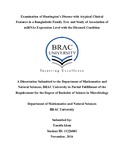| dc.contributor.advisor | Hossain, Dr. M. Mahboob | |
| dc.contributor.advisor | Mannoor, Dr. Md. Kaiissar | |
| dc.contributor.author | Khan, Tanzila | |
| dc.date.accessioned | 2017-08-09T08:53:48Z | |
| dc.date.available | 2017-08-09T08:53:48Z | |
| dc.date.copyright | 2016 | |
| dc.date.issued | 2016-11 | |
| dc.identifier.other | ID 11226001 | |
| dc.identifier.uri | http://hdl.handle.net/10361/8396 | |
| dc.description | This thesis report is submitted in partial fulfillment of the requirement for the degree of B.Sc in Microbiology, 2016. | en_US |
| dc.description | Cataloged from PDF version of thesis report. | |
| dc.description | Includes bibliographical references (page 47-52). | |
| dc.description.abstract | Hereditary neurodegenerative diseases are among the most serious and urgent problems of modern neurology. In Bangladesh perspective this is the first study on Huntington disease, mainly due to lack of initiatives, advanced laboratory facilities and funding opportunities. We have identified a family tree in Naogaon where one of two siblings developed a choreatic movement-related disorder almost 125 year ago while the other remained unaffected. The disorder was passed on to some progenies of subsequent generations. At present, 8 members of the affected family are suffering from this disorder. All progenies of the healthy sibling and their subsequent generations remained unaffected. The age of onset of the disorder varies between 20 to 65 years. Notably, the affected people of earlier generations had late onset of the disorder, whereas the affected people of the later generations are showing early onset of the disease. Magnetic Resonance Imaging (MRI) did not show any significant abnormalities in the brain of a seriously affected patient and therefore further investigations were necessary to determine the molecular diagnosis of the disorder. Our DNA- based studies showed that the concerned disorder was Huntington disease. Huntington Disease (HD) is a fatal autosomal dominant neurodegenerative disorder caused by the progressive loss of nerve cells in the brain characterized by motor, cognitive, and psychiatric disturbances. This disease is caused by genetic defect in the Huntingtin gene (HTT) on chromosome 4. Mutation in the HTT gene involves expansion of CAG tri-nucleotide repeat in exon 1. The normal length of CAG repeat stretch varies from 7 to 36 times in case of healthy person. However, in person with Huntington disease, it can be repeated for up to 250 times. Expansion of CAG triplet repeat stretch within the HTT gene results in a misfolded protein leading to gradual apoptosis of brain cells and progressively disordered involuntary movement and ultimately the patients succumb to death within 6-10 years after onset of the disorder. We first used PCR-based method to check the length of the HTT allele. All 4 unaffected subjects tested had typical HD allele length of 81-84bp (27 to 28 CAG repeats), while all the affected individuals were heterozygous, with one normal HD allele and one expanded allele. We used Sanger DNA sequencing to show that the normal allele had 20 CAG repeats, which were within the previously reported normal range of 6 to 35. The expanded allele had either 53 CAG repeats (7 patients) or 70 CAG repeats (1 patient), confirming the diagnosis of Huntington‘s disease. In addition, we have analyzed the expression patterns of miRNA 125b and miRNA 155 among HD affected patients and healthy controls because these miRNAs are differentially expressed in other neurodegenerative disorders like Parkinson and Alzheimer‘s disorder. miRNA 155 increased about three fold in 1 HD patient among 8 patients compared to healthy controls. On the other hand, change of miRNA 125b expression was not significant in HD affected patients compared to unaffected controls. This is the first study on diagnosis of a neurodegenerative disease using a sequencing based approach in Bangladesh, paving the way for expansion of facilities for diagnosis of other genetic disorders. | en_US |
| dc.description.statementofresponsibility | Tanzila Khan | |
| dc.format.extent | 53 pages. | |
| dc.language.iso | en | en_US |
| dc.publisher | BRAC Univeristy | en_US |
| dc.rights | BRAC University thesis are protected by copyright. They may be viewed from this source for any purpose, but reproduction or distribution in any format is prohibited without written permission. | |
| dc.subject | Family tree | en_US |
| dc.subject | miRNAs | en_US |
| dc.subject | Huntington | en_US |
| dc.title | Examination of huntington’s disease with atypical clinical features in a Bangladeshi family tree and study of association of miRNAs expression level with the diseased condition | en_US |
| dc.type | Thesis | en_US |
| dc.contributor.department | Department of Mathematics and Natural Sciences, BRAC University | |
| dc.description.degree | B. Microbiology | |

